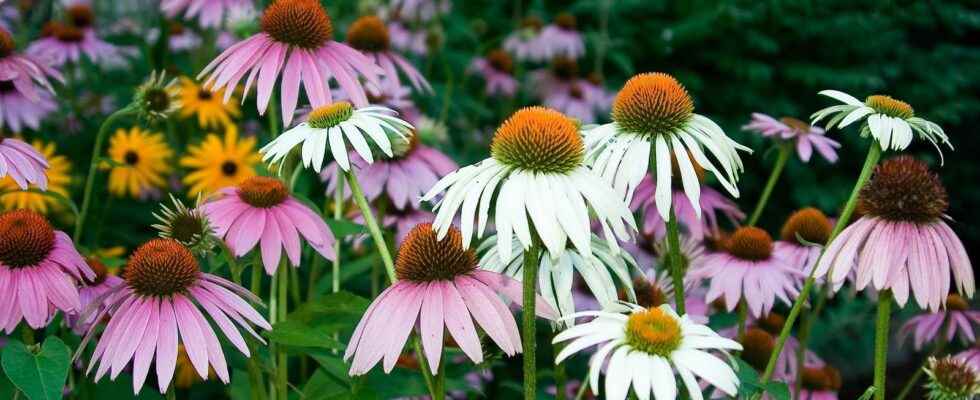This magnificent perennial offers blooms hybrids to the colors live from July to October. Its pink, white, purple, red, yellow or orange flowers color the beds and pots and make it an essential plant to flower the garden for many months.
Appellations
Echinacea (Echinacea) is a member of the family Asteraceae (Asteraceae), just like asters, cosmos, helenies Where chrysanthemums.
Botanical description of echinacea
Very similar to a daisy, this perennial develops tall stems of about one meter with small foliage and large flowers at the ends. The petals can be hanging or erect, thick or thin and of various colors. The flowers are single or double with the heart in the shape of a pompom more or less present; the choice is wide. Among the varieties with amazing flowers and colors, fall for:
- Echinacea purpurea Where Rudbeckia purple: in bloom from July to October;
- Echinacea paradoxa : yellow flowers with drooping petals, flowering from June to August;
- Echinacea pallida : with long, drooping petals, flowering from July to September.
The purple Rudbeckias are the most cultivated with such different and luminous tones, and with blooms that spread from the late June to September.
Origins of Echinacea
This perennial is native to large wet prairies in North America.
Echinacea cultural requirements
Like many perennials, echinacea requires minimal maintenance. Choose a sunny place, sheltered from the winds with a earth rich and well-drained to plant a foot. Planting can take place in the spring or in fall. Not afraid of drought, mulch the foot to keep cool. Place stakes for tall varieties that could bend with the wind. In fall or spring, bring mature compost on foot to feed her. To stimulate future stems, remove the flowers at the end of their life until the fall, taking care to keep a few to shelter the insects in winter. You can propagate it by cutting or dividing, in spring or autumn. Hardy down to -15°C, it does not require winter protection. From the first days of spring without risk of freezeyou can fold the tuft down to ground level.
Use of Echinacea
The long stems of Echinacea make them perfect plants for making bouquets. Associate them with dahlias, gladioli Where sunflowers to flower your summer tables. Combine some varieties with shades of pink with foliage of grasses such as miscanthus or pennisetums to create a graphic massif. Compose a monochrome rose bed with agastaches, persicaires or astilbes. Play with the many varieties to bring touches of color by planting them in pots placed at the four corners of the balcony or the terrace. Grow echinacea in the beds but also in the vegetable garden because these flowers, very honey and nectariferousattract pollinating insects like the bumblebees, bees or butterflies that will come to rest on the vegetables.
You will also be interested
Interested in what you just read?
